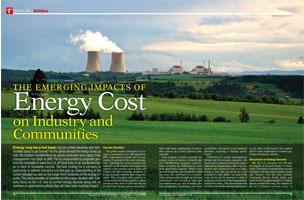
Energy may be a hot topic, but are certain industries and communities about to get burned? As the global demand for energy drives up cost, the location considerations for goods production and supply chain management may begin to shift. This is compounded by proposed government mandates to wean the U.S. off fossil fuels on an accelerated basis in favor of renewable sources. The best strategy for a company or community to address this trend is to first gain an understanding of the current situation as well as the longer-term dynamics of the energy industry. This article provides an overview on the energy situation with a primary focus on the U.S. and its current energy sources along with an overview on government policies that will have wide-reaching impact.

Current Situation
The global annual consumption of energy is estimated at over 480 quadrillion BTU’s equivalent, of which, the U.S. represents 21 percent of the total consumption. Although the recent recession has reduced overall demand, the longer term outlook is for countries such as India and China, with their evolving standards of living, to greatly intensify their energy demand. This is coupled with a global environmental movement against carbon emissions that seeks to eliminate the use of fossil fuel energy sources and replace them with some combination of renewable sources on a fairly rigorous time schedule.
Case in point, if wind is currently the energy source of choice, it would take over 100,000 three megawatt wind turbines to replace the installed U.S. coal-fired generating capacity. While wind derived energy has a great potential, it still has some key challenges to overcome. These include relatively high up-front and maintenance costs as well as high land use requirements per unit of output, distinct geographic limitations, and wind availability and speed is not constant; therefore requiring a backup power source.
Within the U.S., energy consumption is divided into five primary categories with electric power generation being the largest followed by transportation, industrial, residential and commercial uses. It is interesting to note that petroleum as a fuel accounts for only about 1 percent of the total electric power generation while it comprises 95 percent of the transportation-related fuel source. This demonstrates that in order to lessen the national dependence on oil, there would need to be a radical shift to some combination of natural gas, biofuel and electric vehicles.
Discussion on Energy Sources
Oil: The U.S. consumes over 500 million barrels of oil each month, of which, nearly 70 percent is imported from over 60 countries with the largest being Canada and Mexico. The list also includes Venezuela, Russia, Saudi Arabia and Libya as well as approximately 15 million barrels a month from Iraq. The majority of the oil is refined into liquefied petroleum gas (LPG), gasoline, diesel fuel and jet fuel in addition to industrial heating and process steam, residential and commercial heating as well as into plastics, lubricants, chemicals, asphalts and other materials.
Nuclear: often considered a “home grown” option, but looking into the world production of uranium ore, the U.S. is a relatively small player in comparison to the former Soviet Bloc countries (Kazakhstan, Russia and Uzbekistan), Canada, Australia and several African nations (Namibia and Niger). The U.S. is ranked a distant eighth in ore production and a portion must be imported to support nuclear fuel production. Twelve states derive over 30 percent of their power generation from nuclear sources and five states (Connecticut, New Hampshire, New Jersey, South Carolina and Vermont) have over 50 percent of their power from nuclear.
Coal: currently accounts for over 40 percent of the U.S. power generation capacity. U.S. coal reserves that are easily recoverable are estimated at over 275 billion tons, enough to power the country for the next 250 years at current consumption rates. In 29 states, coal represents more than 40 percent of their fuel source for power generation and over 80 percent in Indiana, Kentucky, North Dakota, Missouri, Utah, West Virginia, and Wyoming. The price for delivered coal varies by region of the country, with the lowest cost being in the Midwest and western states, and New England having the highest cost at a price four times that of the lowest cost states.
Coal has had issues with sulfur, mercury and NOx emissions as well as being a major source of carbon dioxide. The Clean Coal initiative sponsored by the coal industry continues to seek viable alternatives for minimizing emissions as well as sequestering carbon dioxide.
Natural Gas: once utilized primarily for peaking power during high demand periods, gas has continued to expand as a source for base load power generation as additional resources have been identified, including the Marcellus Shale formation in Pennsylvania and New York State. There are currently 13 states utilizing natural gas to generate over 30 percent of their electric power with Alaska and Nevada at over 60 percent utilization and Rhode Island at over 90 percent. The price of natural gas has had significant price fluctuations over the past five years, ranging from $4 to over $9 per thousand cubic feet.
Renewable Sources: use of renewable energy sources for power generation is expanding and currently represents over 9 percent of the total U.S. power generation needs, of which, conventional hydro comprises 66 percent, wind 14 percent, biomass 11 percent, geothermal 8.5 percent and solar/photovoltaic less than 1 percent. The overall generation from renewable sources has appreciated only slightly over the past ten years due to the reduction in use of hydro-based power offset by a significant growth in wind power. States with the highest levels of renewable energy derived primarily from conventional hydro include Washington, California, Oregon, New York, Montana and Idaho. Those states with the highest wind turbine installed base include Texas, Iowa, California, Washington, Minnesota and Oregon.
The exploitation of renewable energy sources represents game-changing opportunities but also new challenges. With coal and nuclear fuel sources, power plants can be placed within a reasonable proximity of major population centers as long as there is rail and significant water access available. Sources such as hydro, wind and solar can be placed only in locations that have a high potential for the source, which are frequently in remote areas. In addition, utilizing the renewable energy option often includes the incremental cost of accessing the transmission grid and results in power being conveyed longer distances, with additional line loss rates, to non-local markets.
From a positive perspective, those communities and companies that are in areas conducive for hydro, wind and/or solar, have an opportunity to generate local or on-site power and minimize dependence on the grid except for periodic backup power. This could usher in an era of significant decentralized power generation derived from smaller, local sources. Significantly higher overall efficiencies and system flexibility from renewable sources will be achieved with the development large scale electric storage capabilities (mega batteries) allowing the delivery of electricity during non-generation periods.
Government Influence on Energy
The federal government is attempting to implement an energy policy of shifting away from fossil fuels to renewable sources through either congressional legislation or EPA mandates. From a power generation perspective, the ultimate objective is to eliminate coal fired power plants and other carbon emission sources while stimulating the rapid growth in wind power, solar and other renewable sources. As noted earlier in the article, it will take a lot of wind turbines to displace the over 300,000 MW installed base capacity of coal fired plants.
The federal energy policy is underpinned by the hypothesis that the country can achieve a substantial drop in power demand over the next 20 years due to new efficiencies and conservation. Even if a significant level of conservation is achieved, there will most likely be a concurrent scale-up in the use of electric vehicles that will need incremental capacity for charging on-board batteries.
The concern for a rapidly deployed energy policy is both the immediate and longer-term impacts it will have on states utilizing a significant amount of fossil fuels for power generation. In the short term, industries and utilities within the state would have to incur some type of a carbon tax that would make the cost of doing business relatively high for energy-consuming industries. Longer term, those states that currently utilize coal but have no renewable source backup, such as wind, will be purchasing and wheeling power from another region; substantially driving up costs. Essentially, the emerging energy policy reshapes the U.S. landscape for energy competitiveness.
Cost of Energy by State
Energy in the U.S. is generated, transmitted, and distributed through a variety of organizations, including investor owned, co-op and municipally owned utilities as well as independent power producers. The cost of power in a specific location ultimately depends on the type of supplier, whether the supplier owns the generation and/or distribution network, as well as the types of fuel sources utilized in the generation of power. Within a given state, actual energy cost will vary based on the factors noted above.
Assuming 4 to 8 cents per kilowatt-hour is a typical cost range, most of the U. S. falls within these limits except for Hawaii, Alaska, California, Florida and the Northeast. Although actual rates are under the control of the individual state Public Service Commissions, there is a high degree of correlation between the types of fuel sources utilized and ultimate market price. The highest cost states have petroleum (Hawaii), natural gas and nuclear. The renewable sources such as wind are becoming less expensive as the megawatt rating per unit increases and if there is no significant transmission connection requirements.
If the government imposes a carbon tax on coal fired generation, at least 29 states that have coal as a significant source for their power generation will be significantly affected. This could have drastic impact on industry competitiveness and job retention and expansion at a time when employment is so critical.
Reflection on Energy Trends
The current U.S. energy situation faces a number of challenges including an over-dependence on foreign sources for petroleum to support transportation and the concerns about carbon dioxide emissions derived from manmade sources being a significant contributor to global warming. The solution to our energy challenges is both complex and interdependent and requires both the application of emerging and evolving technologies, the rethinking of the structure and management of the power grid, and a renewed interest in leveraging the U.S. coal reserves – our largest energy resource – as a way of bridging the short-term energy gap. The one constant in our energy future is that the cost of traditional sources of energy will continue to rise and cause companies and communities to consider local options as a hedge. This will also impact the optimization criteria for supply chain management as well as the use of bulk transportation methods whenever possible. Energy, just like the cost of land and labor, will be one of the key location criteria for large energy users.

